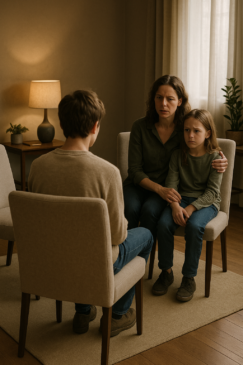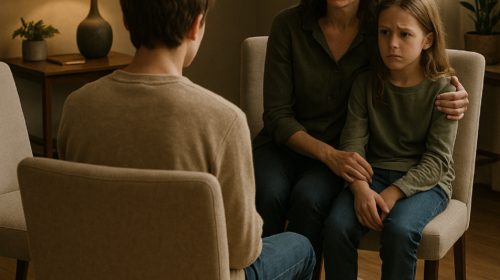Family therapy is supposed to be a safe space—a room where truths can be spoken, hurts can be healed, and the messiness of relationships gets gently untangled. But nothing could have prepared me for the day my soon-to-be-ex-husband, Adam, walked into our therapist’s office… with his new girlfriend in tow.
We’d been separated for four months, stumbling through divorce paperwork while trying to co-parent our eleven-year-old daughter, Molly. Family therapy was our last-ditch effort to keep things civil, to help Molly adjust, and to make sure our pain didn’t become hers. Every week, we met with Dr. Klein in a sunlit office lined with hopeful self-help books and tissue boxes.
The Day Everything Changed
That Tuesday afternoon felt normal, if a little tense. Molly clutched her sketchbook, and I carried my usual blend of nerves and hope. Adam was late, which was typical. But when the waiting room door finally swung open, he wasn’t alone. A woman I’d only seen in passing—pretty, nervous, maybe early thirties—walked in behind him.
“Hi,” Adam said, avoiding my eyes. “This is Sarah.”
For a heartbeat, no one spoke. Dr. Klein blinked in surprise. “I wasn’t aware we’d have a guest today.”
Adam cleared his throat. “Well, Sarah is a big part of my life now. I thought it might help if she joined us.”

I looked at Molly, whose eyes had gone wide and wet. In that moment, my heartbreak twisted into something sharper—anger, confusion, embarrassment. We hadn’t even finalized our divorce. Molly barely spoke about Adam’s “friend,” and here she was, in the one place meant to be just ours.
When Boundaries Are Crossed
The session that followed was a train wreck. Dr. Klein tried to hold the space, asking each of us to share our feelings. Sarah sat on the edge of her seat, awkward and out of place. Adam defended his choice: “I want transparency. I don’t want secrets.”
But the truth was, this wasn’t about honesty. It was about boundaries—about letting our daughter process one huge change before forcing another. Molly shut down completely, scribbling furiously in her sketchbook and refusing to speak. I found myself fighting tears and rage, torn between wanting to scream and wanting to run.
When the hour was up, Dr. Klein gently suggested that next time, it would be better to discuss who’s attending in advance. Sarah offered an uncomfortable apology as they left together. I watched them go, my heart pounding with questions I couldn’t ask in front of Molly.
Picking Up the Pieces
That night, I tucked Molly into bed. She finally whispered, “Why was she there, Mom?” I hugged her close. “I don’t know, honey. But it wasn’t fair to you. You get to feel however you feel about it.”
I called Dr. Klein later, explaining how blindsided and unsafe I’d felt. We agreed to reset the ground rules: only parents, only for Molly, no new partners until everyone was ready. Adam wasn’t happy, but I stood my ground.
What I Learned
Divorce exposes every weak spot in a family. But it also teaches you where your boundaries are—and how to defend them. I learned that you can’t control what someone else does, but you can control your response. Standing up for your child, your peace, and your healing is not selfish—it’s necessary.
Adam and I continued therapy, just the three of us. It was never easy, but it got better. Molly found her voice again, and in time, we made space for healing.
Final Thought
If someone brings their new partner into a sacred space before you or your child are ready, speak up. Boundaries are not about shutting people out—they’re about making room for honest healing. Protect your space, protect your family, and trust that it’s okay to demand the respect you deserve.



